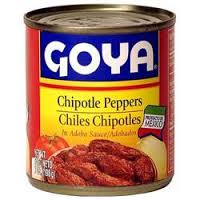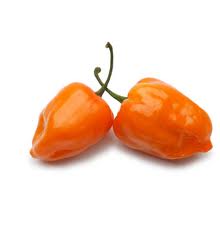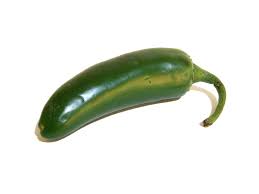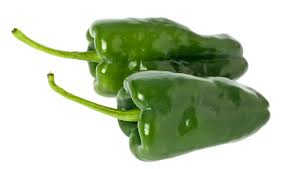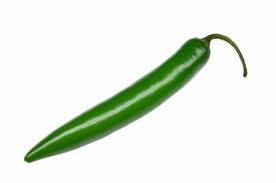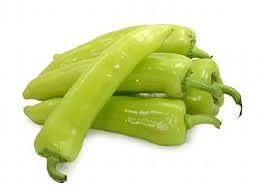What is the difference between chilies and peppers? They are actually the same thing and are differentiated by their potency. Chili peppers are fruit from the plant from the genus Capsicum which are members of the nightshade family. Chili peppers have been a part of the human diet in the Americas since at least 7500 BC. They originated in the Americas and there is archaeological evidence at sites located in southwestern Ecuador that chili peppers were cultivated more than 6000 years ago. A physician on Columbus’ second voyage to the West Indies in 1493, brought the first chili peppers to Spain and first wrote about their medicinal effects in 1494. They were likely introduced to Asia by Portuguese traders in the 16th century.
Peppers are commonly broken down into three groupings: bell peppers, sweet peppers, and hot peppers. The substances that give chili peppers their intensity when ingested or applied topically are capsaicin and related chemicals, referred to collectively as capsaicinoids. When consumed, capsaicinoids bind with pain receptors in the mouth and throat that are responsible for sensing heat. These receptors send a message to the brain that the person has consumed something hot and the brain responds to the burning sensation by raising the heart rate, increasing perspiration and releasing endorphins.
The “heat” of chili peppers was historically measured in Scoville heat units (SHU), a method developed in 1912, which is a measure of the dilution of an amount of chili extract added to sugar syrup before its heat becomes detectable to a panel of tasters; the more it has to be diluted to be undetectable, the more powerful the variety and therefore the higher the rating. Smaller chili peppers are usually hotter than larger varieties.The modern method for measuring the SHU rating uses liquid chromatography.
Some of the more common chili peppers are:
Bell Pepper- (SHU 0) red, green and yellow varieties add color and texture to recipes.
Cayenne – (SHU 30,000-50,000) often used in Cajun recipes. Green cayenne peppers ripen in the summer, while hotter red cayenne peppers come out in the fall. They are also dried and ground.
Chipotle – (SHU 3,500-8,000) a smoked, dried whole jalapeno pepper, usually canned.
Ghost Pepper (SHU 855,000-1,463,700) – the hottest of all peppers, with no culinary nor medicinal uses.
Habanero – (SHU 100,000-350,000) extremely hot chiles with a fruity flavor.
Jalapeno – (SHU 3,500-8,000) spicy chiles with rich flavor. Green jalapenos are best in the late summer, while red jalapenos appear in the fall. Canned jalapenos aren’t as fiery as the fresh ones.
Poblano – (SHU 1,000-2,500) These mild, heart-shaped peppers are large and have very thick walls, which make them great for stuffing. They’re best in the summer.
Paprika – (2,500-8,000) Common in Hungarian cuisine. Usually sold dry or ground, with some versions smoked.
Scotch Bonnet – (SHU 100,000-350,000) almost indistinguishable from the habanero, except that it’s a bit smaller; popular in the Caribbean.
Serrano – (SHU 10,000-23,000) These have thin walls, so they don’t need to be charred, steamed, and peeled before using.
Sweet Banana Pepper – (SHU 100-900) long, thin-skinned yellow pepper with a mild, fruity flavor often used in salads.
Culinary Uses
Chili peppers are used both fresh or dried. The leaves of every species of Capsicum are edible and do not contain any toxins. They are often cooked as “greens” or added to soups. Fresh or dried chilies are often used to make hot sauces that can be added to other foods to add spice.
Red chilies contain large amounts of Vitamin C and small amounts of Vitamin A. Yellow and especially green chilies (which are essentially unripe fruit) contain a lower amount of both substances. In addition, peppers are a good source of most B vitamins, in particular Vitamin B6 and are very high in potassium, magnesium, and iron.
Chili peppers contain oils which can burn skin and especially eyes. Avoid direct contact as much as possible. Many cooks wear rubber gloves while handling chilies, or generously grease your fingers with any kind of shortening (even the cooking sprays can help). In any case, after working with the chilies, be sure to wash your knives, cutting board and anything else thoroughly with hot soapy water.
Medicinal Uses
Although chilies have been used as a topical analgesic to ease the pain of arthritis, herpes zoster (cold sores) and headaches, a study done in 2008 linked it to skin cancer. Capsaicin extracted from chilies is used in pepper spray.
Resources
allrecipes.com
culinaryarts.about.com
Wikipedia



